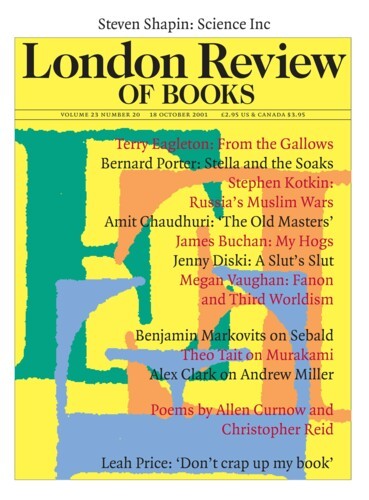You’ve zoomed through it often enough
on the long grind north, the grim dash south –
why not take a break?
Slip off the motorway
at any one of ten tangled junctions
and poke your nose, without compunction,
into the unknown.
Get systematically lost.
At the first absence of a signpost,
opt for the least promising lane,
or cut into the truck traffic
along some plain,
perimeter-fence-lined stretch of blacktop
heading nowhere obvious.
Open your mind
to the jarring yellow
of that hillside rape crop, the grim Norse green
of that fir plantation, where every tree
steps forward to greet you
with the same zombie gesture
of exclamation, the last-ditch brown of –
what could it be? Something to do with pigs?
Row on row
of miniature Nissen huts
laid out like a new speculative estate
in acres of glistening mud, behind an electronic gate . . .
But don’t stop now.
Press on,
undistracted by the lush hedgerows
(of which there are none)
or the silence of the songbirds.
Other counties
can match these. It’s the essence of Bollockshire
you’re after: its secrets, its blessings and bounties.
So keep driving,
past sly-windowed farms,
lying there with hoards of costly machinery
in their arms, like toys they won’t share;
past Bald Oak Hill,
down the more shaded side of which
the Bollockshire Hunt has scuffled
many a morning to its kill;
past St Boldric’s church,
with the slant steeple,
which Cromwell’s lads once briefly visited,
leaving behind them saints re-martyred,
the Virgin without her head;
past Bewlake Manor’s
dinky Gothic gatehouse, now the weekend habitat
of London media or money people;
past the isolated
Bulldog pub,
with its choice of scrumpies, microwave grub,
bouncy castle and back-room badger fights –
past all that,
until, if you are lucky,
you hit the famous ring road. Thrown down
decades ago, like a gigantic concrete garland
around the county town,
riddled and plugged
by the random dentistry of maintenance work
and chock-a-block with contraflow,
it must, you feel,
be visible from the moon.
One road sign hides another. There are orange cones
galore. Each cultivated roundabout island
is, if possible, more off-key
than the one before.
But don’t stick here all afternoon:
Blokeston itself has to be seen,
via the brick maze
of its bygone industrial outskirts.
This is where Shas Balk invented his machine
for putting a true, tight twist in string,
where they once supplied the world
with all it needed
of bicycle saddles and cigarette papers,
where cough syrup was king.
Round the corner,
just when you least expect,
there’s Blokeston FC, home of ‘The Blockers’,
and Blokeston Prison, by the same no-frills architect.
Unmissable from any position,
the Bulwark Brewery
stands up in a haze of its own malty vapours,
which even today’s counterwafts of Tandoori
cannot contest.
Now, turn east or west,
and you’ll find yourself on a traffic-planner’s
one-way inward spiral, passing at speed
through older and older
parts of town –
the impeccable Georgian manners
of Beauclerc Square, built on slave-trade money;
bad Bishop Bloggs’s school;
the crossroads where
the Billhook Martyrs were tortured and burned –
until you reach the river Bleak.
Squeeze, if you can,
over the Black Bridge,
then park and pay – assuming this isn’t the week
of the Billycock Fair, or Boiled Egg Day,
when they elect the Town Fool.
From here, it’s a short step
to the Bailiwick Hall Museum and Arts Centre.
As you enter, ignore the display
of tankards and manacles, the pickled head
of England’s Wisest Woman;
ask, instead, for the Bloke Stone.
Surprisingly small, round, featureless,
pumice-grey,
there it sits, dimly lit,
behind toughened glass, in a room of its own.
Be sure to see it, if you’ve a taste
for this sort of primitive conundrum.
Most visitors pass
and won’t even leave their vehicles,
keen by this time to make haste
back to the life they know,
and to put more motorway under them.
Send Letters To:
The Editor
London Review of Books,
28 Little Russell Street
London, WC1A 2HN
letters@lrb.co.uk
Please include name, address, and a telephone number.

